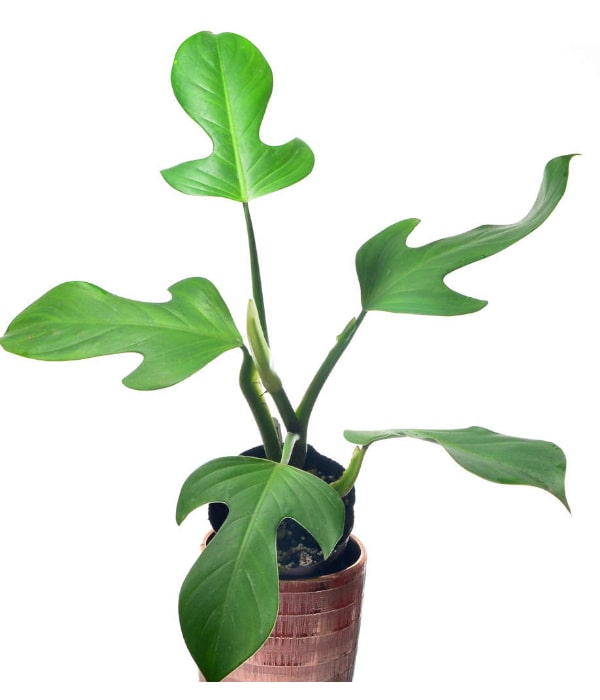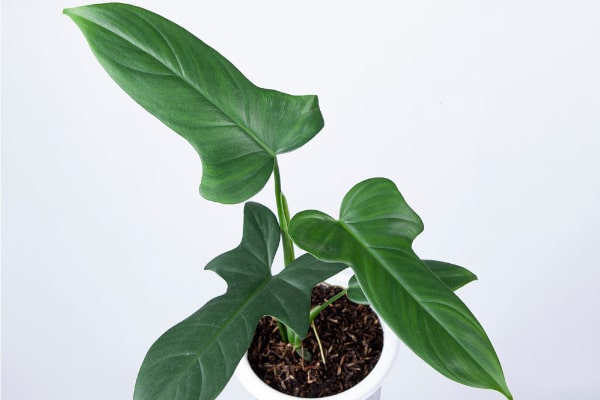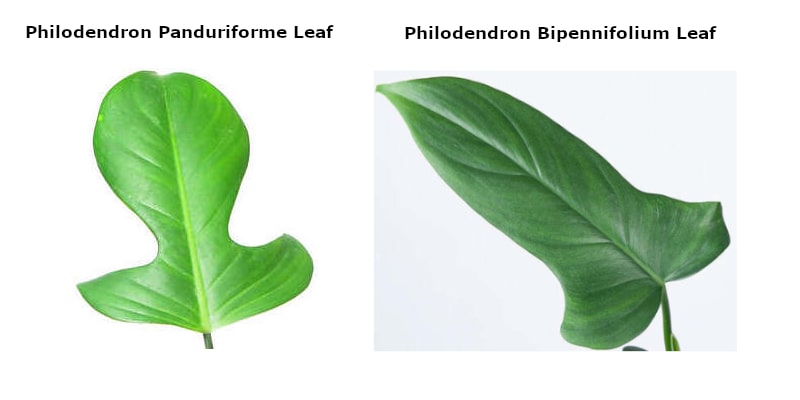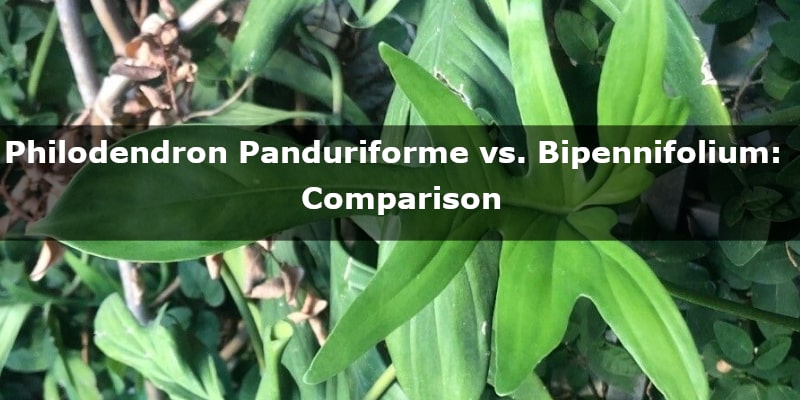Many people think that philodendron panduriforme, and bipennifolium are the same plants.
However, it’s not true, and in this post, I’ll tell you all the differences between philodendron panduriforme, and bipennifolium.
Philodendron Panduriforme: at a Glance

Philodendron is a large genus of flowering plants in the family Araceae. The plant occurs in Peru, Ecuador, Brazil, Colombia, and the Venezuelan region of Cerro Yapacana.
The species is known to botany as a scandent (climbing) vine. The low-climbing hemiepiphytic philodendron panduriforme is typically found at elevations between 350-480 feet (120 to 150 meters) above sea level.
Philodendron panduriforme grows upon other plants but may begin life as a seed placed on a tree’s branch by a bird or grow upwards from the soil, climbing a tree, as a seed dropped on the ground.
Philodendron panduriforme is an aroid, which means that the plant that reproduces by producing an inflorescence known to science as a spathe and spadix.
Philodendron Bipennifolium: at a Glance

Philodendron bipennifolium is commonly known as fiddleleaf. The plant comes from Argentina and Brazil, wrapping itself around the trees when growing.
It has a skinny stem with aerial roots, making it hemi-epiphyte foliage and helping it grow like a vine. It features leathery textured glossy green leaves.
Whether climbing or cascading, this unusual aroid is relatively simple to care for.
Philodendron Panduriforme vs. Bipennifolium: Similarities
Philodendron panduriforme, and bipennifolium have many similarities, including size, plant family, appearance, light, and water requirements.
1. Size
The size of both plants is similar, however, it will depend on many conditions.
Philodendron panduriforme can grow up to 6 feet (180 cm) tall if given a structure to climb on. You can use a moss pole to help your philodendron grow taller and produce larger leaves.
The size of philodendron bipennifolium is similar. If given space, it usually reaches 5-6 feet (150-180 cm). However, in many cases, this plant can grow even up to 7 feet (213 cm).
2. Plant family
Both philodendron panduriforme, and bipennifolium belong to Araceae family.
Aracear is a family in which flowers are borne on a type of inflorescence called a spadix. The spadix is usually accompanied by, and sometimes partially enclosed in, a spathe or leaf-like bract. This is a family of 140 genera and about 3,750 known species.
3. Appearance
Both plants look similar. That’s why many people think that these are the same plants.
Philodendron panduriforme, and bipennifolium feature similar sizes, leaves (but not identical), stems, and overall shape. Differences in appearance are really minimal.
4. Light requirements
Philodendron panduriforme, and bipennifolium belong to the same family, thus their light requirements are the same.
These plants can’t take direct sunlight shining down on them. Indirect sunlight is how these philodendrons get sunlight in the rainforest.
5. Watering needs
Both plants need moist soil at all times during the warmer months. Overwatering might stunt their growth, or develop root rot.
During winter, they don’t need to be watered as often. They want the soil to dry all the way out before watering.
Oh, and if you need fertilizer for your philodendron, you can buy this one on Amazon.
Philodendron Panduriforme vs. Bipennifolium: Differences
The differences between philodendron panduriforme, and bipennifolium include the different shape of leaves, different temperature requirements, and cost.
1. Leaves
Probably the biggest difference between philodendron panduriforme, and bipennifolium is the shape of the leaves. If you know the characteristics of the leaves of these plants, you’ll easily recognize them.

Philodendron panduriforme has shallowly three-lobed leaf blades with more rounded tips, similar to oak leaves. The lateral lobes curved outward, making the leaf blades look like a pandurate or fiddle. But in juvenile plants, leaf blades are oblong with slightly outward flaring lateral lobes near the leaf base.
Philodendron bipennifolium has leaf blades shaped like a horse’s head with more deeply cut lobes, pointed posterior lobes with an open sinus, obtusely triangular middle lobes, and an oblong-elliptic pointed lower lobe. The small section of posterior lateral ribs is nude near where it attaches to the petiole. Juvenile leaves have a slightly heart-shaped base with rounded upper lobes and ragged edges.
2. Temperature requirements
You can also spot the difference in slightly different temperature requirements.
The philodendron panduriforme needs temperatures between 60 °F (16 °C) and 75 °F (24 °C). Colder or warmer temperatures can cause stunted growth.
On the other hand, philodendron bipennifolium prefers warmer temperatures between 75 °F (24 °C) and 85 °F (29 °C). This plant won’t survive freezing temperatures.
3. Cost
The prices of both plant also vary.
Because the philodendron panduriforme is rarer than philodendron bipennifolium, it costs more. You can purchase it from $15, even up to $99, but in most cases, it costs about $30.
You can buy philodendron bipennifolium for as low as $10, but if you pay $25, it’s a good price.
Philodendron Panduriforme: Pros and Cons
Pros
- Great plant for home
- Not a heavy feeder
- You can adjust its size by using a moss pole
Cons
- More expensive than philodendron bipennifolium
- Toxic to animals and humans
Philodendron Bipennifolium: Pros and Cons
Pros
- It can withstand higher temperatures
- Pretty cheap
- Great ornamental plant
Cons
- Might require humidifier indoors
Conclusion
The differences between philodendron panduriforme, and bipennifolium are really slight. The biggest one is the leaf shape. The top lobe on the leaves of the panduriforme is more rounded than bipennifolium’s. Other differences include the prices of plants, and temperature requirements.
Sources
exoticrainforest.com, plantly.io, plantindex.com, plantophiles.com, en.wikipedia.org

